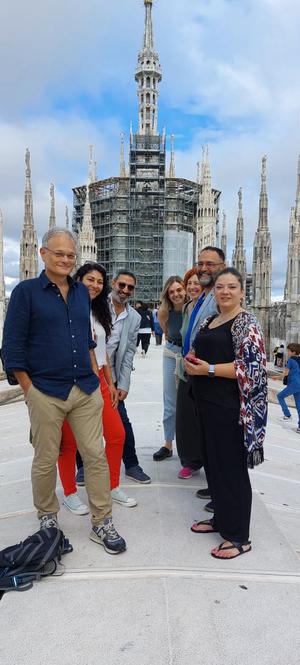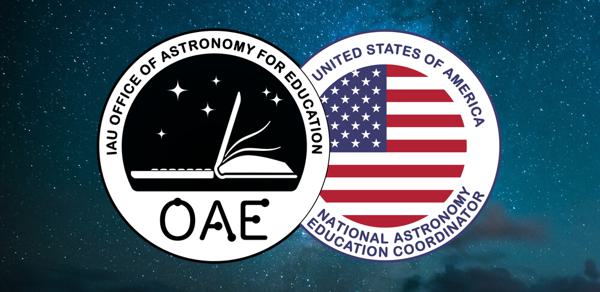Sabir: students at the center of learning
Published: 14th November 2024 10:40 (UTC)
Designing and launching water rockets into space, transforming your classroom into an "asteroid mining" team, searching for exoplanets with a mobile phone, or trying to go back in time to "save" Galileo. These are the educational activities being published on AstroEDU by Sabir, the project from the OAE Center Italy of the IAU (International Astronomical Union), based on the latest principles of science education. Sabir's journey lasted several months and culminated in a week-long event from September 2 to 7 in Milan, with the participation of a group of teachers and researchers from across the Mediterranean. We discuss about this project with Stefano Sandrelli, Director of the OAE Center Italy, and the project's creator and coordinator.
Sabir is an I-OAE project aimed at developing educational activities for high schools using innovative teaching methods. We invited four teams of colleagues from various countries, led by their respective NAECs (National Astronomy Education Coordinators) for the IAU, to participate. Many of them had already taken part in a similar working group during the Summer School held in 2023 in Morocco. The team's work took place throughout the year with a series of online meetings, culminating in a week-long event in Milan, hosted by the INAF Brera Astronomical Observatory. Representing the four teams were Jean-Pierre Saghbini from Lebanon, Nayra Rodríguez Eugenio from Spain, Ayşegül Fulya Yelkenci from Turkey, and Hassane Darhmoui from Morocco. The group was completed by Dunja Fabian, NAEC from Slovenia, Gloria Tirabassi from our office, and myself. We three acted as facilitators of discussions, organizers, and observers, essentially the coordinators.
We asked each group to propose an activity developed using traditional methods, to share it, ready to be deconstructed, reconstructed, and modified. The idea was to transform these classic activities into resources based on the inquiry-based learning (IBL) method, which, simply put, aims at having students lead the learning process.
The final result consists of four proposals that, starting this month, will be published on astroEDU to be used by as many teachers as possible worldwide. The first, challenges students to build their best rocket (water-powered), asking questions like what is the "right" amount of water to use, how to stabilize its trajectory, and what height it can reach. Then, there's an activity that challenges students to propose a mission to exploit asteroid resources by finding the most suitable ones using orbits, spectra, and astronomical databases. A third activity opens the door to the magical world of exoplanet research through a simple experiment, the basic elements of which are a cardboard box and a couple of mobile phones. Lastly, we will publish an activity to "save" Galileo and support the arguments of Copernicanism: a comparison between geocentric and heliocentric models through observations of planets like Venus and Mars.
We often talk about innovative techniques applied to education, such as the inquiry method you mentioned earlier. Could you explain what it means and why it is so important in the spirit of the OAE?
As I said before, IBL is a teaching and learning approach where students lead the process. This means that each individual needs to be very active in seeking the necessary information and can also contribute personally. Typically, we try to engage people by showing them a natural phenomenon or presenting them with a challenge, perhaps through an experiment, or any other stimulus that engages their curiosity. The groups then decide the direction of inquiry for that phenomenon or how to tackle the challenge. Each group is free to choose what aspects to focus on and find the information needed to address the problem. This allows groups to investigate at their own pace: everyone can contribute. The important aspect is that the investigation is conducted firsthand, that the groups learn to exchange opinions and information, and that they are willing to discuss the methods they have chosen. In short, to learn from interaction.
This simple fact puts people in front of others' perspectives: when they realize that different choices could have been made, it encourages them to raise the challenge's level. Participants are also naturally inclined to argue, hypothesize, and engage in constructive discussion, and often this dynamic leads to fun. These are all elements of what is called critical thinking, a divergent way of thinking that never takes knowledge for granted, and which is somewhat at the heart of our activities.
Let's take a step back and tell us the story behind Sabir: what does this name mean and how did the idea for this project come about?
The name Sabir identifies a lingua franca, an uncodified language born out of practical use and needs. Specifically, it was used in the Mediterranean basin from the 11th to the 19th century among sailors and merchants. We wanted to emphasize that, through what we are doing, we are using a common language that is not any of the languages each of us speaks at home, but is a mixture of expressions. And that everything comes from the desire to communicate and engage in dialogue.
The project naturally arose from past experiences, particularly the first and fundamental one, which we called MIRTO/STEAM-Med, developed from November 2021 to all of 2022, culminating in a week-long in-person event in a very special place chosen for its symbolic significance: Lampedusa. With MIRTO (Mediterranean Informal Round Table Online), we carried out initiatives mainly aimed at primary school students, while with Sabir, we tried to add a contribution for secondary school students, even though the method we used is indeed applicable to younger students as well.
I imagine that these self-training experiences, which bring people from all over the world together in one place, are also an incredible moment of shared life.
What struck me right away about these experiences was the immediate ability to laugh together: it happened as soon as we met in person in Lampedusa, after months of online meetings. It was July, with terrible heat, late flights, lost luggage, a lot of work to do, and the mobile connection cable had been cut. Moreover, we had chosen to camp to save money and be together in a very informal setting. In short, there were some discomforts, let's admit it. Yet, we laughed a lot. This happens every time we see each other. It could be due to a clumsy attempt to take a selfie or a fountain that, just when one of us approaches, seems to run out of water: none of this would be funny to an outside observer. But we laugh like kids. Dario Fo, Nobel Prize for Literature in 2007, said that "only in fun, passion, and laughter can true cultural growth be achieved." It's nice to think that our co-design helps cultural growth through these elements.
Speaking of co-design: this is also a term that often recurs in the projects and activities of the OAE Center Italy. Can you explain what it means and why it is so important? Especially for our office, that has the focus on Mediterranean countries among its objectives.
The Mediterranean is a very stimulating yet certainly complex basin of multiculturalism. Coordinating the activities of Mediterranean countries means interacting with a community of colleagues who live and work in very diverse countries and conditions. It quickly became clear to us that the only way to work well together and establish relationships that were not just occasional or formal was to jointly design every step we were taking.
Co-design sums up all this: a group of people from different countries collaborating, sharing values (from the value of science to the value of history or traditions), transforming the ideas or practices of some community members into ideas or practices recognized as common. Without forgetting its origins. This is also achieved by translating from the working language, English, into each of the languages of the countries involved in the process. Sometimes the transformation is significant, sometimes less drastic. But in the end, everyone knows that the final result is a shared product, coming from the work, history, and ideas of all.
Share on:
Contacts
Stefano SandrelliOAE Center Italy
Manager
stefano.sandrelliatinaf.it
Livia Giacomini
OAE Center Italy
Deputy manager and astroEDU editor-in-chief
livia.giacominiatinaf.it










